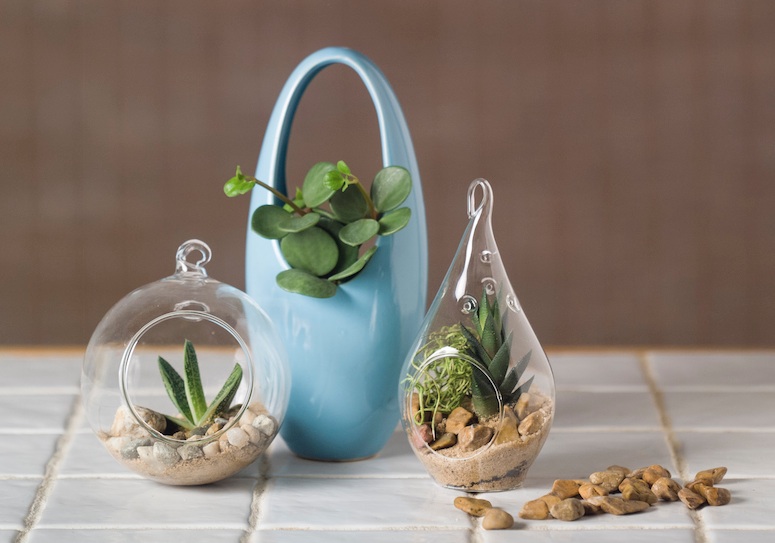
Maria Colletti is no ordinary gardener. Instead, her green designs are small and portable. Hers is the domain of the terrarium — she creates miniature landscapes thriving in a world of glass, sunlight and minimal intervention. Known as the “terrarium savant” by a legion of fans, she has cultivated both expertise and a following that, like her creations, has grown organically with time.
Now the horticulturalist and green design queen is focusing on a more sizable project. Her first book, Terrariums: Gardens Under Glass, is already available for purchase online and will be available in bookstores starting in September.
As a child, Colletti was instinctively drawn to nature and greenery. Tending to her family garden in Westchester County, she was fascinated by the variety of botanical worlds on display. Each new plant and its ecology proved a fascination: she loved the heady scent of lilac, the sight of ant colonies marching across peony flower buds, the mysterious beds of mint and the feeling of pruning summer roses. By age 12, Colletti had amassed a collection of 25 houseplants in her bedroom alone.
Fast forward to today, and the author and gardener boasts degrees in horticulture and cultural anthropology and has managed award-winning indoor atriums for Xerox, IBM and the Guggenheim Museum. Since 2003, she has been the store manager for The Shop in the Garden at The New York Botanical Garden. Her terrarium creations are available from the store or can be custom commissioned. She also runs seasonal workshops around New York and will be bringing her expertise (and book) on tour with her in the coming months.
The terrarium builder has also created pieces to complement or pay tribute to other gardeners. One of her favorite pieces was inspired by Abby Aldrich’s Rockefeller Garden. Miniature stone paths and a Chinese Moon Gate inside a Victorian glasshouse created not only a fitting “homage” to Aldrich but channelled her eye for architecture and design. Colletti shows a similar inclination for structure and composition. Citing Frank Lloyd Wright, Japanese moss gardens and the structural aspect of everything from hair styling to topiaries, it’s clear design plays as critical a role in her contained compositions as the horticultural.
Having also spent time working for a publishing house in New York, Colletti knows what it takes to produce a good book. Her first work is designed not so much as an homage to what she calls the “craze” for terrariums, but rather a “complete compendium.” Filled with helpful photos, the book is designed to be a practical guide for anyone planning to create their own little landscape.
From conceptual design to managing complex ecosystems, Terrariums: Gardens Under Glass is a world of knowledge that is accessible yet satisfying for gardeners of all levels. Colletti views gardening as a “universal language,” or a need for green that transcends the urban versus rural, land or language. As a case in point, designers around the world have shared their ideas with her on social media. All are equally inspired to convey subjective interpretations of nature through the same medium of the terrarium. Now she hopes the book will inspire others to follow suit.
Terrarium Top Tips
- For beginners, a straight sided cookie jar with a lid is the best type of container. Its shape and sealed environment will provide just the right kind of airflow for your landscape to grow well.
- Choose plants with strong leaves. Each leaf should feel leathery to the touch a sign the plant will stand up to humidity and a new environment.
- Add stones or pebbles to the bottom of the terrarium jar to create a drainage area for excess moisture.
- Adding a little charcoal to the base of the terrarium jar under the soil will help draw out any impurities and extra moisture from the environment.
- Cover the stones and charcoal with good quality potting soil.
- You can experiment with a range of colors, objects and foliage for your terrarium. Plan your landscape before you create. Arid landscapes vs. forested ones will require different plants and objects. For example, you might want to add mini pine cones or dried moss to a forested landscape compared to stones and cacti for another. It’s easier to plan before you plant!
- Water your plants BEFORE you put them in the terrarium. This avoids adding unnecessary extra moisture to the enclosed environment, which can lead to mold and pest issues.
- Once your landscape is created, seal the jar with a lid. Your terrarium is ready!
- To maintain a good environment, monitor the sides of the jar for signs of condensation, dead organic matter or mould. Wiping away moisture with a clean cloth and removing decay will help keep the terrarium ecosystem in balance.
- With minimal attention, your lidded terrarium will last for several years or more without added water. Remember: opening the jar lid will expose the landscape to dry air and let some of the moisture out. There is no need to mist lidded terrariums, only if your terrarium is an open vessel or if you choose to remove the lid.
Terrariums: Gardens Under Glass is published by Cool Springs Press and available to order online or from book stores starting in September.
Photos courtesy of Maria Colletti



